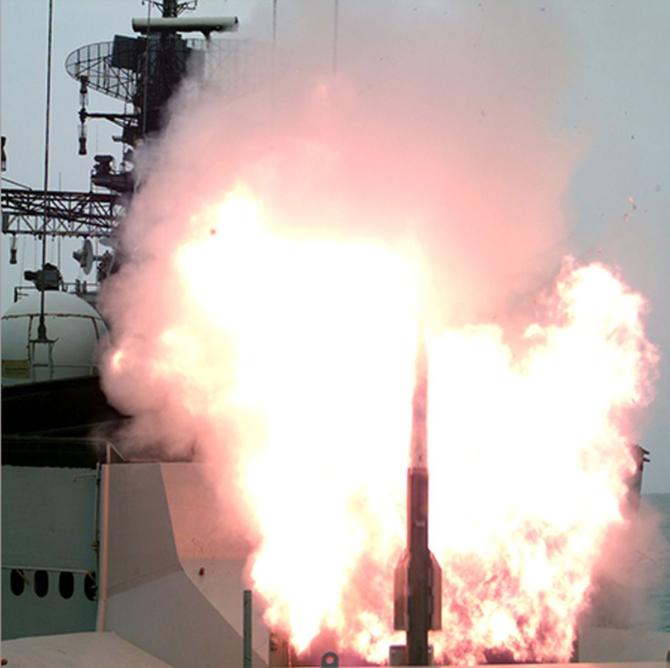The VL-SRSAM, which DRDO developed for the Indian Navy, was fired from a warship at a high-speed aerial target mimicking incoming enemy aircraft.

Indian naval warships just became more heavily protected and difficult to strike with aircraft and anti-ship missiles, with the successful flight-test of the Vertical Launch Short Range Surface to Air Missile (VL-SRSAM).
The VL-SRSAM, which the Defence Research and Development Organisation (DRDO) has indigenously developed for the Indian Navy, was fired from a warship at a high-speed aerial target that was mimicking an incoming enemy aircraft.
India's most modern naval warships, such as the Visakhapatnam-class destroyers and Nilgiri-class frigates, are equipped with multiple layers of defence against their biggest threats: Enemy aircraft and sea-skimming anti-ship missiles.
The first line of defence is provided by the Indo-Israeli medium range surface to air missiles (MRSAMs), which are capable of shooting down hostile aerial threats at ranges out to 70 kilometres.
If the MRSAM fails to destroy the incoming threat at long ranges, the warship launches its VL-SRSAMs at shorter ranges of 25-30 kilometres.
During mid-course flight, the VL-SRSAM missile uses a fibre-optic, gyroscope-based, inertial guidance mechanism. With-lock-on-before-launch (LOBL) and lock on after launch (LOAL) capability, the missile receives mid-course update via datalink. Then, in the terminal phase, the missile switches to active radar homing.
The VL-SRSAM is an indigenous upgrade to the two-decade-old Israeli Barak 1 surface-to-air missile system on board Indian warships. It is derived from DRDO's highly successful Astra Mark-1 air-to-air missile, which was recently fired successfully from a Sukhoi-30MKI fighter.
Several countries that have developed successful air-to-air missiles have modified them into other formats: The US converted the AIM-7 Sparrow into the RIM-7 Sea Sparrow. The French MICA missile has a land-launched variant called VL-MICA.
The platform provides an integrated solution that incorporates both the missile and weapon control system (WCS). Equipped with 360 degrees interception capability, it can detect and engage threats from different directions.
The VL-SRSAM missile has a smokeless exhaust and a jet-vane-driven thrust vector control that enables quick reaction time on vertical launch. The VL-SRSAM system is conceived for area as well as point defence to protect naval platforms.
Each vertical launch system (VLS) holds 40 missiles in a twin, quad-pack canister configuration. Each carries eight missiles for hot launch, which can be installed in an arrangement of multiple launch systems based on availability of space on the warship.
In its first tests, DRDO successfully test-fired two VL-SRSAMs on February 22, 2021. The maiden launch tested the efficacy of the VLS and missile's maximum and minimum range. Both missiles fired successfully intercepted their targets with pinpoint accuracy.
In the second test on December 7, 2021, the VL-SRSAM was successfully fired by DRDO from the Integrated Test Range in Chandipur off the coast of Odisha. The launch was conducted from a vertical launcher against an electronic target at a very low altitude.
The aim was to validate integrated operation of all weapon system components including the vertical launcher unit with controller, canisterised flight vehicle and weapon control system.
There are also plans to use it as a short-range air defence system for the Indian Air Force.
DRDO has planned to offload the manufacture of the missile to a private sector firm, making it one of the first major weapons platforms to be produced by private industry under the aegis of Aatmanirbhar Bharat (self-reliant India) project.












 © 2025
© 2025